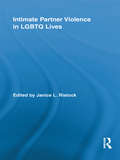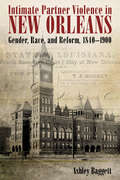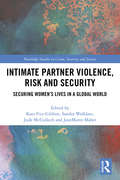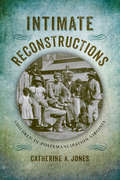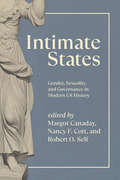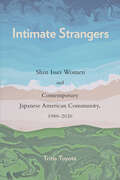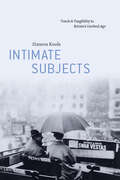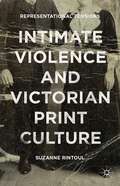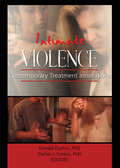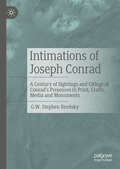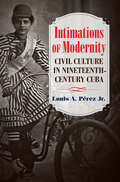- Table View
- List View
Intimate Partner Violence in LGBTQ Lives (Routledge Research in Gender and Society)
by Janice L. RistockQueer lives remain at the margins of most academic inquiry into domestic violence. When same-sex violence is considered, it is most commonly as an "added on," without close attention to the specificity and meaning of violence within the lives of lesbian/ gay/ bisexual/ transgender/Two-Spirit and queer people (LGBTQ). This edited volume seeks to change this discourse by bringing together the most innovative research about intimate partner violence that is specific to the lives of LGBTQ people. Including contributions based on research conducted in the United States, the United Kingdom, Canada and Australia, the volume is framed around central themes: conceptualizing violence; exploring differing spaces and lived experiences of violence; and the ethical challenges of responding to violence. The contributors also consider issues of race, class, gender, sexuality and other social differences, moving beyond a simple gender lens to one involving a framework of intersectionality.
Intimate Partner Violence in New Orleans: Gender, Race, and Reform, 1840-1900
by Ashley BaggettAshley Baggett uncovers the voices of abused women who utilized the legal system in New Orleans to address their grievances from the antebellum era to the end of the nineteenth century. Poring over 26,000 records, Baggett analyzes 421 criminal cases involving intimate partner violence—physical or emotional abuse of a partner in a romantic relationship—revealing a significant demand among women, the community, and the courts for reform in the postbellum decades. Before the Civil War, some challenges and limits to the male privilege of chastisement existed, but the gendered power structure and the veil of privacy for families in the courts largely shielded abusers from criminal prosecution. However, the war upended gender expectations and increased female autonomy, leading to the demand for and brief recognition of women's right to be free from violence. Baggett demonstrates how postbellum decades offered a fleeting opportunity for change before the gender and racial expectations hardened with the rise of Jim Crow. Her findings reveal previously unseen dimensions of women's lives both inside and outside legal marriage and women's attempts to renegotiate power in relationships. Highlighting the lived experiences of these women, Baggett tracks how gender, race, and location worked together to define and redefine gender expectations and legal rights. Moreover, she demonstrates recognition of women's legal personhood as well as differences between northern and southern states' trajectories in response to intimate partner violence during the nineteenth century.
Intimate Partner Violence, Risk and Security: Securing Women’s Lives in a Global World (Routledge Studies in Crime, Security and Justice)
by Sandra Walklate Kate Fitz-Gibbon JaneMaree Maher Jude McCullochThis edited collection addresses intimate partner violence, risk and security as global issues. Although intimate partner violence, risk and security are intimately connected they are rarely considered in tandem in the context of global security. Yet, intimate partner violence causes widespread physical, sexual and/or psychological harm. It is the most common type of violence against women internationally and is estimated to affect 30 per cent of women worldwide. Intimate partner violence has received significant attention in recent years, animating political debate, policy and law reform as well as scholarly attention. In bringing together a range of international experts, this edited collection challenges status quo understandings of risk and questions how we can reposition the risk of IPV, and particularly the risk of IPH, as a critical site of global and national security. It brings together contributions from a range of disciplines and international jurisdictions, including from Australia and New Zealand, United Kingdom, Europe, United States, North America, Brazil and South Africa. The contributions here urge us to think about perpetrators in more nuanced and sophisticated ways with chapters pointing to the structural and social factors that facilitate and sustain violence against women and IPV. Contributors point out that states not only exacerbate the structural conditions producing the risks of violence, but directly coerce and control women as both citizens and non-citizens. States too should be understood as collaborators and facilitators of intimate partner violence. Effective action against intimate partner violence requires sustained responses at the global, state and local levels to end gender inequality. Critical to this end are environmental issues, poverty and the divisions, often along ‘race’ and ethnic lines, underpinning other dimensions of social and economic inequality.
Intimate Partner Violence: Effective Procedure, Response And Policy
by Elicka Peterson Sparks Kit GruelleWritten by experts with a combined 50 years of experience teaching and researching in the field of domestic abuse, Intimate Partner Violence: Effective Procedure, Response, and Policy provides practical instruction for practitioners and lay people responding to domestic violence, as well as ideas for policymakers working to create solutions to the violence. Narratives by victims of intimate partner abuse provide a framework from which students and practitioners can assess address problems of domestic abuse. This book focuses on what can be practically done to address the problem of domestic violence for individual practitioners as well as policymakers, lawmakers, and criminal justice practitioners.
Intimate Partner Violence: Effective Procedure, Response and Policy
by Kit Gruelle Elicka SparksWritten by experts with a combined 50 years of experience teaching and researching in the field of domestic abuse, Intimate Partner Violence: Effective Procedure, Response, and Policy provides practical instruction for practitioners and lay people responding to domestic violence, as well as ideas for policymakers working to create solutions to the violence. Narratives by victims of intimate partner abuse provide a framework from which students and practitioners can assess address problems of domestic abuse. This book focuses on what can be practically done to address the problem of domestic violence for individual practitioners as well as policymakers, lawmakers, and criminal justice practitioners.
Intimate Politics: How I Grew Up Red, Fought for Free Speech, and Became a Feminist Rebel
by Bettina ApthekerAt eight years old, Bettina Aptheker watched her family's politics play out in countless living rooms across the country when her father, historian and U.S. Communist Party leader Herbert Aptheker, testified on television in front of the House on Un-American Activities Committee in 1953. Born into one of the most influential U.S. Communist families whose friends included W. E. B. Du Bois, Paul Robeson, and Elizabeth Gurley Flynn, Bettina lived her parents' politics witnessing first-hand one of the most dramatic upheavals in American history. She also lived with a terrible secret: incest at the hands of her famous father and a frightening and lonely life lived inside a home wrought with family tensions.A gripping and beautifully rendered memoir, Intimate Politics is at its core the story of one woman's struggle to still the demons of her personal world while becoming a controversial public figure herself. This is the story of childhood sexual abuse, abortion, sexual violence, activism, and the triumph over one's past. It's about FBI harassment and persecution, Jewish heritage, and lesbian identity. It is, finally, about the courage to speak one's truth despite the consequences and to break the sacred silence of family secrets.
Intimate Politics: How I Grew Up Red, Fought for Free Speech, and Became a Feminist Rebel
by Bettina F. ApthekerAt eight years old, Bettina Aptheker watched her family's politics play out in countless living rooms across the country when her father, historian and U. S. Communist Party leader Herbert Aptheker, testified on television in front of the House Un-American Activities Committee in 1953. Born into one of the most influential U. S. Communist families whose friends included W. E. B. Du Bois, Paul Robeson, and Elizabeth Gurley Flynn, Bettina lived her parents' politics witnessing first-hand one of the most dramatic upheavals in American history. She also lived with a terrible secret: incest at the hands of her famous father and a frightening and lonely life lived inside a home wrought with family tensions. Includes photos with captions.
Intimate Reconstructions: Children in Postemancipation Virginia (A Nation Divided: Studies in the Civil War Era)
by Catherine A. JonesIn Intimate Reconstructions, Catherine Jones considers how children shaped, and were shaped by, Virginia's Reconstruction. Jones argues that questions of how to define, treat, reform, or protect children were never far from the surface of public debate and private concern in post-Civil War Virginia. Through careful examination of governmental, institutional, and private records, the author traces the unpredictable paths black and white children traveled through this tumultuous period. Putting children at the center of the narrative reveals the unevenness of the transitions that defined Virginia in the wake of the Civil War: from slavery to freedom, from war to peace, and from secession to a restored but fractured union. While some children emerged from the war under the protection of families, others navigated treacherous circumstances on their own. The reconfiguration of postwar households, and disputes over children's roles within them, fueled broader debates over public obligations to protect all children. The reorganization of domestic life was a critical proving ground for Reconstruction. Freedpeople's efforts to recover children strained against white Virginians' efforts to retain privileges formerly undergirded by slavery. At the same time, orphaned children, particularly those who populated the streets of Virginia's cities, prompted contentious debate over who had responsibility for their care, as well as rights to their labor. By revisiting conflicts over the practices of orphan asylums, apprenticeship, and adoption, Intimate Reconstructions demonstrates that race continued to shape children's postwar lives in decisive ways. In private and public, children were at the heart of Virginians' struggles over the meanings of emancipation and Confederate defeat.
Intimate States: Gender, Sexuality, and Governance in Modern US History
by Nancy F. Cott Margot Canaday Robert O. SelfFourteen essays examine the unexpected relationships between government power and intimate life in the last 150 years of United States history. The last few decades have seen a surge of historical scholarship that analyzes state power and expands our understanding of governmental authority and the ways we experience it. At the same time, studies of the history of intimate life—marriage, sexuality, child-rearing, and family—also have blossomed. Yet these two literatures have not been considered together in a sustained way. This book, edited and introduced by three preeminent American historians, aims to close this gap, offering powerful analyses of the relationship between state power and intimate experience in the United States from the Civil War to the present. The fourteen essays that make up Intimate States argue that “intimate governance”—the binding of private daily experience to the apparatus of the state—should be central to our understanding of modern American history. Our personal experiences have been controlled and arranged by the state in ways we often don’t even see, the authors and editors argue; correspondingly, contemporary government has been profoundly shaped by its approaches and responses to the contours of intimate life, and its power has become so deeply embedded into daily social life that it is largely indistinguishable from society itself. Intimate States makes a persuasive case that the state is always with us, even in our most seemingly private moments.
Intimate States: Gender, Sexuality, and Governance in Modern US History
by Nancy F. Cott Margot Canaday Robert O. SelfFourteen essays examine the unexpected relationships between government power and intimate life in the last 150 years of United States history. The last few decades have seen a surge of historical scholarship that analyzes state power and expands our understanding of governmental authority and the ways we experience it. At the same time, studies of the history of intimate life—marriage, sexuality, child-rearing, and family—also have blossomed. Yet these two literatures have not been considered together in a sustained way. This book, edited and introduced by three preeminent American historians, aims to close this gap, offering powerful analyses of the relationship between state power and intimate experience in the United States from the Civil War to the present. The fourteen essays that make up Intimate States argue that “intimate governance”—the binding of private daily experience to the apparatus of the state—should be central to our understanding of modern American history. Our personal experiences have been controlled and arranged by the state in ways we often don’t even see, the authors and editors argue; correspondingly, contemporary government has been profoundly shaped by its approaches and responses to the contours of intimate life, and its power has become so deeply embedded into daily social life that it is largely indistinguishable from society itself. Intimate States makes a persuasive case that the state is always with us, even in our most seemingly private moments.
Intimate States: Gender, Sexuality, and Governance in Modern US History
by Nancy F. Cott Margot Canaday Robert O. SelfFourteen essays examine the unexpected relationships between government power and intimate life in the last 150 years of United States history. The last few decades have seen a surge of historical scholarship that analyzes state power and expands our understanding of governmental authority and the ways we experience it. At the same time, studies of the history of intimate life—marriage, sexuality, child-rearing, and family—also have blossomed. Yet these two literatures have not been considered together in a sustained way. This book, edited and introduced by three preeminent American historians, aims to close this gap, offering powerful analyses of the relationship between state power and intimate experience in the United States from the Civil War to the present. The fourteen essays that make up Intimate States argue that “intimate governance”—the binding of private daily experience to the apparatus of the state—should be central to our understanding of modern American history. Our personal experiences have been controlled and arranged by the state in ways we often don’t even see, the authors and editors argue; correspondingly, contemporary government has been profoundly shaped by its approaches and responses to the contours of intimate life, and its power has become so deeply embedded into daily social life that it is largely indistinguishable from society itself. Intimate States makes a persuasive case that the state is always with us, even in our most seemingly private moments.
Intimate Strangers: Arendt, Marcuse, Solzhenitsyn, and Said in American Political Discourse
by Andreea Deciu RitivoiAndreea Deciu Ritivoi is professor of English at Carnegie Mellon University. Her research focuses on immigration, exile, political discourse, argumentation theory, and intellectual history. She is the author of Yesterday's Self: Nostalgia and the Immigrant Identity and Paul Ricoeur: Tradition and Innovation in Rhetorical Theory.
Intimate Strangers: Arendt, Marcuse, Solzhenitsyn, and Said in American Political Discourse
by Andreea RitivoiHannah Arendt, Herbert Marcuse, Alexander Solzhenitsyn, and Edward Said each steered major intellectual and political schools of thought in American political discourse after World War II, yet none of them was American, which proved crucial to their ways of arguing and reasoning both in and out of the American context. In an effort to convince their audiences they were American enough, these thinkers deployed deft rhetorical strategies that made their cosmopolitanism feel acceptable, inspiring radical new approaches to longstanding problems in American politics. Speaking like natives, they also exploited their foreignness to entice listeners to embrace alternative modes of thought. Intimate Strangers unpacks this "stranger ethos," a blend of detachment and involvement that manifested in the persona of a prophet for Solzhenitsyn, an impartial observer for Arendt, a mentor for Marcuse, and a victim for Said. Yet despite its many successes, the stranger ethos did alienate many audiences, and critics continue to dismiss these thinkers not for their positions but because of their foreign point of view. This book encourages readers to reject this kind of critical xenophobia, throwing support behind a political discourse that accounts for the ideals of citizens and noncitizens alike.
Intimate Strangers: Commercial Surrogacy in Russia and Ukraine and the Making of Truth
by Veronika SieglZooming in on commercial surrogacy in Russia and Ukraine, Intimate Strangers addresses market expansion into the intimate spheres of life that play out on women's bodies as mothers and workers. Veronika Siegl follows the inner workings of a surrogacy market marked by secrecy, distrust, and anonymous business relationships. She explores intended mothers' anxious struggles for a child in light of stigmatized infertility and the aggressive biopolitics of motherhood; the uncertain but pragmatic pathways in and out of fertility clinics as surrogates navigate harsh economic realities and resist being objectified or morally judged; and the powerful role of agents and doctors who have found a profitable niche in nurturing and facilitating other people's existential hopes. Intimate Strangers discusses these issues against the backdrop of ultra-conservatism and moral governance in Russia, the rising international popularity of the Ukrainian surrogacy market, and the pervasiveness of neo-liberal ideologies and individualized notions of reproductive freedom.
Intimate Strangers: Shin Issei Women and Contemporary Japanese American Community, 1980-2020 (Asian American History & Cultu)
by Tritia ToyotaAt the end of the twentieth century, many twenty-something Japanese women migrated to places like Southern California with few skills and an overall lack of human capital. These women, members of the shin Issei community, sought economic opportunities unavailable to them in their homeland. In Intimate Strangers, shin Issei women tell stories of precarity, inequality, and continuing marginality, first in Japan, where they were restricted by gendered social structures, and later in the United States, where their experiences were compounded by issues such as citizenship. Intimate Strangers charts the experiences of shin Issei lives: their existence in Japan prior to migration, their motivations for moving to the United States, their settlement, and their growing awareness of their place in American society. Toyota chronicles how these resilient young women became active agents in circumventing social restrictions to fashion new lives of meaning. The Nikkei community (Americans of Japanese ancestry who were born in the United States) has been transformed by the inclusion of shin Issei, and Toyota describes the tensions around intergroup negotiations over race, identity, and the possibility of common belonging. Intimate Strangers is a perceptive study of migration and community incorporation enacted around cultural differences and processes.
Intimate Subjects: Touch and Tangibility in Britain's Cerebral Age
by Simeon KooleAn insightful history of nineteenth- and twentieth-century Britain told through a single sense: touch. When, where, and who gets to touch and be touched, and who decides? What do we learn through touch? How does touch bring us closer together or push us apart? These are urgent contemporary questions, but they have their origins in late nineteenth- and early twentieth-century Britain, when new urban encounters compelled intense discussion of what touch was, and why it mattered. In this vividly written book, Simeon Koole excavates the history of these concerns and reveals how they continue to shape ideas about “touch” in the present. Intimate Subjects takes us to the bustling railway stations, shady massage parlors, all-night coffee stalls, and other shared spaces where passengers, customers, vagrants, and others came into contact, leading to new understandings of touch. We travel in crammed subway cars, where strangers negotiated the boundaries of personal space. We visit tea shops where waitresses made difficult choices about autonomy and consent. We enter classrooms in which teachers wondered whether blind children could truly grasp the world and labs in which neurologists experimented on themselves and others to unlock the secrets of touch. We tiptoe through London’s ink-black fogs, in which disoriented travelers became newly conscious of their bodies and feared being accosted by criminals. Across myriad forgotten encounters such as these, Koole shows, touch remade what it meant to be embodied—as well as the meanings of disability, personal boundaries, and scientific knowledge. With imagination and verve, Intimate Subjects offers a new way of theorizing the body and the senses, as well as a new way of thinking about embodiment and vulnerability today.
Intimate Violence and Victorian Print Culture: Representational Tensions
by Suzanne Rintoultimate Violence and Victorian Print Culture identifies an important contradiction in Victorian representations of abuse: the simultaneous compulsion to expose and to obscure brutality towards women in intimate relationships. Exploring representations of abuse in a variety of contexts not limited to marriage, Suzanne Rintoul illustrates how intimate violence became both spectacular and unspeakable in the Victorian period, and how the discernible tension between exposure and concealment across multiple texts as well as within individual ones signals more than confusion about the 'correct' way to deal with the problem of abuse. Rintoul argues that in diverse material consumed by a broad cross-section of Victorian society this tension positions the vulnerable female body as a space through which to explore more general cultural uncertainties regarding gender and class-based hierarchies, and that it often renders the battered woman a cite of social and political oppositionality.
Intimate Violence: A Study of Injustice
by Julie BlackmanTraditional analyses of domestic battery often point to the batterer's need for power and control to explain patterns of violent behavior. Offering a nonjudgmental and compassionate view of the interior life of the batterer, Intimate Violence moves beyond this explanation and transforms our understanding of the psychic origins of abuse. The book is divided into three main sections. The first assesses psychoanalytic understanding of the inner mechanisms of the batterer's violent behavior toward close family members, pointing to disruptions in the abuser's "narcissistic equilibrium." The second section looks more broadly at the ideas of "batterer" and "victim," and the ways these categories—and the social stigma and support accorded respectively—may impede healing and resolution. The third section addresses various treatment methods that promise permanent changes in batterers' behavior.Intimate Violence also deals frankly with the dynamics of the therapist/client relationship in battery cases, particularly transference and countertransference. How do therapists deal with feelings of revulsion for the batterer's behavior, or for the batterer him- or herself? How do they resist the very human urge within themselves to punish their clients? Scalia persuasively argues that these issues subtly undermine counseling, causing resistance to develop within both parties, and that a new approach to therapy is needed. His analysis suggests that "emotional communication" in the context of prolonged and deep psychoanalysis enables patient and practitioner alike to transcend cycles of recrimination and defensiveness.
Intimate Violence: Attacks Upon Psychic Interiority
by Joseph ScaliaOffering a compassionate view of the interior life of the batterer, this book explains the inner mechanisms of the batterer's violent behavior, analyzes society's negative depictions of abuse as well as general ideas concerning victims, and proposes alternative views. Finally the book addresses treatment methodologies that will result in permanent change.
Intimate Violence: Contemporary Treatment Innovations
by Donald Dutton Daniel Jay SonkinTake an updated approach to treating partner violence! Intimate Violence: Contemporary Treatment Innovations examines new and innovative approaches to treating domestic violence, de-emphasizing the unilateral, psychoeducational approach in favor of treatment modalities that focus on the offenders' individual characteristics. The book presents up-to-date information on techniques for working with men and women who commit intimate partner violence, moving past a "one size fits all" mentality to develop treatment that affects long-term changes in beliefs, behaviors, and attitudes. It also includes a brief history of perpetrator treatment, feminist perspectives on treatment, and recent research findings that suggest domestic violence offenders need more than education and attitude adjustment. Intimate Violence explores key treatment issues not usually found in more traditional approaches, particularly shame and attachment. The book focuses on alternate methods based on assessment and tailored to meet the treatment needs of specific populations, including women, lesbian batterers, men with borderline personality disorder (BPD), and Aboriginal men living in Canada. It also examines the Beit Noam, an Israeli live-in intervention program for abusive men, and addresses the legal and ethical issues surrounding the court-mandated treatment of offenders. An international, interdisciplinary panel of practitioners, researchers, and academics also discuss: Dialectical Behavior Therapy (DBT) Physical Aggression Couples Treatment (PACT) attachment theory therapeutically based interventions feminist/social learning treatment individual, group, and integrative therapies transpersonal psychology systems thinking field theory and much more! Intimate Violence: Contemporary Treatment Innovations is an essential resource for clinicians, researchers, educators, and advocates working in psychology, social work, counseling, law, health care, and related disciplines.
Intimations of Infinity: The Cultural Meanings of the Iqwaye Counting and Number Systems
by Jadran MimicaThis is a remarkable work which captures the reader's imagination as only few books do. From a description of the counting system of Iqwaye people of Papua New Guinea, the author develops a deeper and broader interpretation of the Iqwaye kinship system and cosmology, culminating in a powerful critique of western assumptions about the development of rational thought.
Intimations of Joseph Conrad: A Century of Sightings and Citings of Conrad’s Presences in Print, Crafts, Media and Monuments
by G.W. Stephen BrodskyMaster mariner and pioneer author of Modernist technique Joseph Conrad (1857-1924) achieved such eminence in his lifetime that his presence, explicit or implicit, could be found in the lives and works of several contemporaries of consequence. Through the century since his death he has lived on as a presence in the works of later authors to the present day. A collection spanning fifteen years of the present author’s sightings of Conrad’s presences are not only literary, but also memorial. Monuments, sculpture, ships, plaques, the performing arts, cabinetry and even a pub find a place. Each sighting is described in its context—a couple of certain or likely sightings by Conrad, such as Molière and Matthew Arnold, and the rest sightings or ambient intimations of Conrad’s presence –fiction and social commentary in novels and film by significant authors who carry on his legacy, from contemporaries such as H.G. Wells, Ford Madox Ford and F. Scott Fitzgerald to moderns George Orwell, Albert Camus, John Le Carrée, Ian MacEwan and John Banfield, among others. Presented in a clear yet poetic prose style, this record of Conrad’s influence on these contemporary and later writers brings a significant dimension to their interpretation; conversely Conrad’s place may be perceived more precisely in the historically broadening canon from Modernist to Postmodern. Together with its illustrations, Intimations of Joseph Conrad is a novel and unique concept, as entertaining as it is informative.
Intimations of Modernity: Civil Culture in Nineteenth-Century Cuba
by Louis A. PérezLouis A. Perez Jr.'s new history of nineteenth-century Cuba chronicles in fascinating detail the emergence of an urban middle class that was imbued with new knowledge and moral systems. Fostering innovative skills and technologies, these Cubans became deeply implicated in an expanding market culture during the boom in sugar production and prior to independence. Contributing to the cultural history of capitalism in Latin America, Perez argues that such creoles were cosmopolitans with powerful transnational affinities and an abiding identification with modernity. This period of Cuban history is usually viewed through a political lens, but Perez, here emphasizing the character of everyday life within the increasingly fraught colonial system, shows how moral, social, and cultural change that resulted from market forces also contributed to conditions leading to the collapse of the Spanish colonial administration.Perez highlights women's centrality in this process, showing how criollas adapted to new modes of self-representation as a means of self-fulfillment. Increasing opportunities for middle-class women's public presence and social participation was both cause and consequence of expanding consumerism and of women's challenges to prevailing gender hierarchies. Seemingly simple actions--riding a bicycle, for example, or deploying the abanico, the fan, in different ways--exposed how traditional systems of power and privilege clashed with norms of modernity and progress.
Intimations of Nostalgia: Multidisciplinary Explorations of an Enduring Emotion
by Michael Hviid JacobsenNostalgia, a complex and multi-layered emotion, has gained interest since the turn of the century in both society and academic circles. Written by an international group of scholars, this volume investigates the relationship between nostalgia and contemporary social issues from a multidisciplinary perspective. From history and political theory to marketing and media, each chapter discusses the way nostalgia has been presented within a disciplinary context and shows how it has evolved over time as a topic of research. Casting light on many recent changes in society and culture, this is an important contribution to the study of nostalgia and emotions.
Intimität und Immunität: Zum Einfluss der Sexualität auf Gesundheit und soziale Systeme
by Klaus M. BeierDie Beziehung als Ressource für die Gesundheit Wie wirken sich intime Beziehungen auf unsere psychische und körperliche Gesundheit aus? Die intime Vertrautheit in einer gelingenden Beziehung hat eine gesundheitsfördernde, immunisierende Kraft. Doch gleichzeitig stehen uns dabei eigene Denkmuster, kulturelle Prägungen und unbewusste Verhaltensweisen im Weg. Ziel dieses Buch ist es, sowohl die gesundheitsfördernde Kraft von Beziehungen aufzuzeigen als auch die Hindernisse, die sich ergeben können, um diese Kraft in Anspruch zu nehmen. Der Autor zeigt präventive Möglichkeiten auf und berücksichtigt dabei den ganzheitlichen und interdisziplinären Ansatz der Sexualwissenschaft mit allen drei Dimensionen der Sexualität: Lust, Beziehung und Fortpflanzung. Zahlreiche Fallbeispiele geben einen Einblick in die sexualmedizinische Praxis. Ein Buch für alle, die sich für die Zusammenhänge zwischen Sexualität, Gesundheit und Gesellschaft interessieren.
